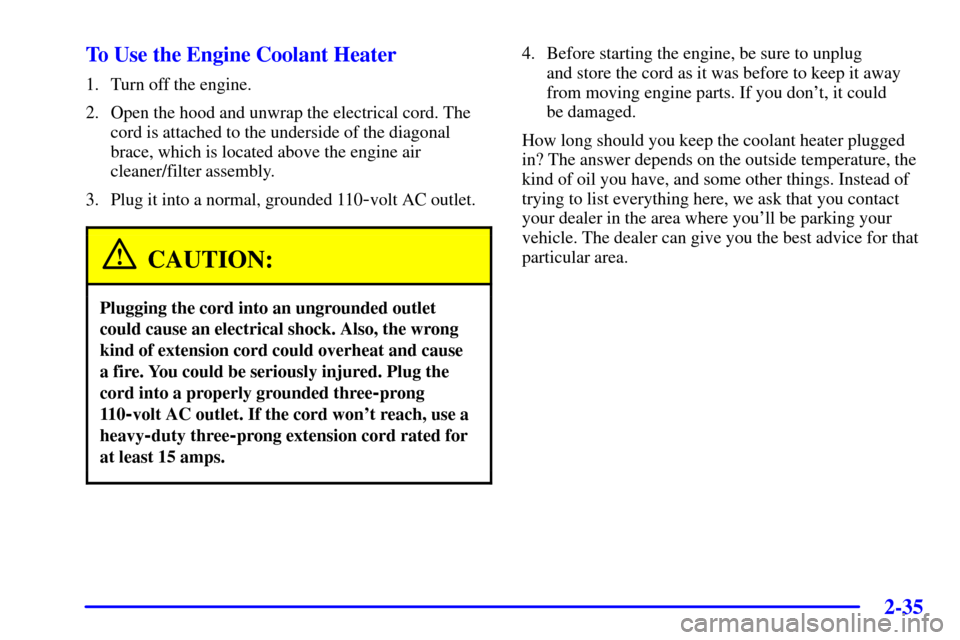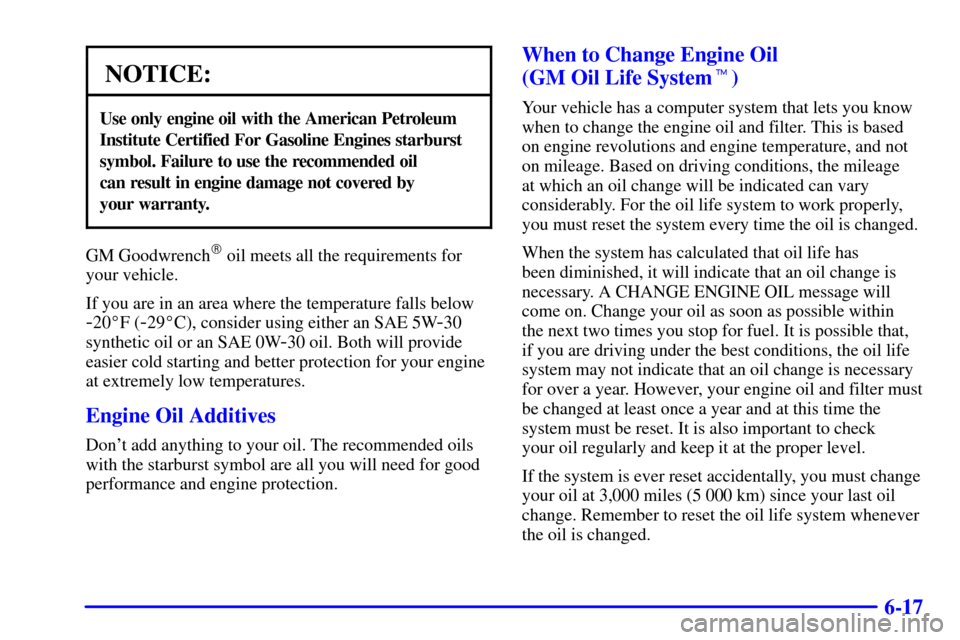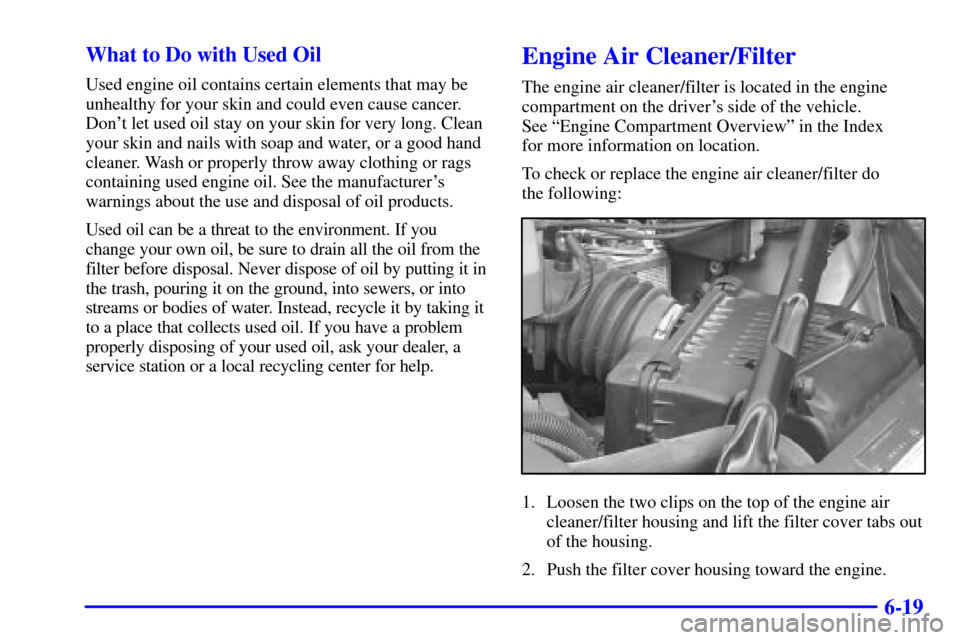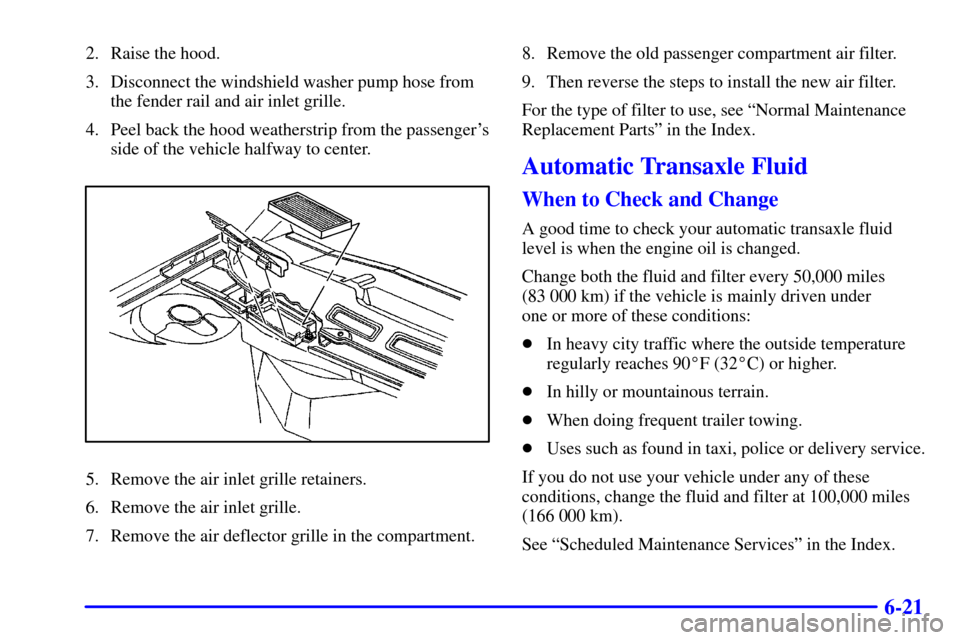Page 101 of 397

2-35
To Use the Engine Coolant Heater
1. Turn off the engine.
2. Open the hood and unwrap the electrical cord. The
cord is attached to the underside of the diagonal
brace, which is located above the engine air
cleaner/filter assembly.
3. Plug it into a normal, grounded 110
-volt AC outlet.
CAUTION:
Plugging the cord into an ungrounded outlet
could cause an electrical shock. Also, the wrong
kind of extension cord could overheat and cause
a fire. You could be seriously injured. Plug the
cord into a properly grounded three
-prong
11 0
-volt AC outlet. If the cord won't reach, use a
heavy
-duty three-prong extension cord rated for
at least 15 amps.
4. Before starting the engine, be sure to unplug
and store the cord as it was before to keep it away
from moving engine parts. If you don't, it could
be damaged.
How long should you keep the coolant heater plugged
in? The answer depends on the outside temperature, the
kind of oil you have, and some other things. Instead of
trying to list everything here, we ask that you contact
your dealer in the area where you'll be parking your
vehicle. The dealer can give you the best advice for that
particular area.
Page 290 of 397

6-
6-1
Section 6 Service and Appearance Care
Here you will find information about the care of your vehicle. This section begins with service and fuel information,
and then it shows how to check important fluid and lubricant levels. There is also technical information about your
vehicle, and a part devoted to its appearance care.
6
-2 Service
6
-3 Fuel
6
-5 Fuels in Foreign Countries
6
-6 Filling Your Tank
6
-8 Filling a Portable Fuel Container
6
-8 Checking Things Under the Hood
6
-12 Engine Oil
6
-19 Engine Air Cleaner/Filter
6
-20 Passenger Compartment Air Filter
(If Equipped)
6
-21 Automatic Transaxle Fluid
6
-24 Engine Coolant
6
-28 Radiator Pressure Cap
6
-28 Power Steering Fluid
6
-29 Windshield Washer Fluid
6
-31 Brakes6
-34 Battery
6
-35 Bulb Replacement
6
-40 Windshield Wiper Blade Replacement
6
-41 Tires
6
-51 Appearance Care
6
-51 Cleaning the Inside of Your Vehicle
6
-53 Care of Safety Belts
6
-55 Cleaning the Outside of Your Vehicle
6
-58 Finish Damage
6
-59 GM Vehicle Care/Appearance Materials
6
-60 Vehicle Identification Number (VIN)
6
-60 Service Parts Identification Label
6
-61 Electrical System
6
-68 Replacement Bulbs
6
-68 Capacities and Specifications
6
-70 Normal Maintenance Replacement Parts
Page 299 of 397
6-10 Engine Compartment Overview
When you open the hood on the 3400 V6 (Code E) engine, you'll see the following:
A. Windshield Washer
Fluid Reservoir
B. Lower Underhood Fuse Block
C. Upper Underhood Fuse Block
D. Radiator Pressure CapE. Engine Coolant RecoveryTank
F. Power Steering Fluid Reservoir
G. Engine Oil Fill Cap
H. Engine Oil DipstickI. Transaxle Fluid Dipstick
J. Brake Master
Cylinder Reservoir
K. Engine Air Cleaner/Filter
Page 300 of 397
6-11
When you open the hood on the 3800 V6 (Code K) engine, you'll see the following:
A. Windshield Washer
Fluid Reservoir
B. Lower Underhood Fuse Block
C. Upper Underhood Fuse Block
D. Radiator Pressure CapE. Engine Coolant RecoveryTank
F. Power Steering Fluid Reservoir
(low in engine compartment)
G. Engine Oil Dipstick
H. Engine Oil Fill CapI. Transaxle Fluid Dipstick
J. Brake Master
Cylinder Reservoir
K. Engine Air Cleaner/Filter
Page 306 of 397

6-17
NOTICE:
Use only engine oil with the American Petroleum
Institute Certified For Gasoline Engines starburst
symbol. Failure to use the recommended oil
can result in engine damage not covered by
your warranty.
GM Goodwrench� oil meets all the requirements for
your vehicle.
If you are in an area where the temperature falls below
-20�F (-29�C), consider using either an SAE 5W-30
synthetic oil or an SAE 0W
-30 oil. Both will provide
easier cold starting and better protection for your engine
at extremely low temperatures.
Engine Oil Additives
Don't add anything to your oil. The recommended oils
with the starburst symbol are all you will need for good
performance and engine protection.
When to Change Engine Oil
(GM Oil Life System�)
Your vehicle has a computer system that lets you know
when to change the engine oil and filter. This is based
on engine revolutions and engine temperature, and not
on mileage. Based on driving conditions, the mileage
at which an oil change will be indicated can vary
considerably. For the oil life system to work properly,
you must reset the system every time the oil is changed.
When the system has calculated that oil life has
been diminished, it will indicate that an oil change is
necessary. A CHANGE ENGINE OIL message will
come on. Change your oil as soon as possible within
the next two times you stop for fuel. It is possible that,
if you are driving under the best conditions, the oil life
system may not indicate that an oil change is necessary
for over a year. However, your engine oil and filter must
be changed at least once a year and at this time the
system must be reset. It is also important to check
your oil regularly and keep it at the proper level.
If the system is ever reset accidentally, you must change
your oil at 3,000 miles (5 000 km) since your last oil
change. Remember to reset the oil life system whenever
the oil is changed.
Page 307 of 397

6-18
How to Reset the Change Engine Oil Message
The GM Oil Life System� calculates when to change
your engine oil and filter based on vehicle use. Anytime
your oil is changed, reset the system so it can calculate
when the next oil change is required. If a situation
occurs where you change your oil prior to a being turned
on, reset the system.
After changing the engine oil, the system must be reset.
To reset the CHANGE ENGINE OIL message use one
of the following procedures:
Using the Radio
1. Turn the ignition to ACC or ON, with the radio off.
2. Press and hold the TUNE DISP button on the radio for
at least five seconds until SETTINGS is displayed.
3. Press the SEEK PTYPE up or down arrow to scroll
through the main menu.4. Scroll until OIL LIFE appears on the display.
5. Press the 1 PREV or 2 NEXT button to enter the
submenu. RESET will be displayed.
6. Press the TUNE DISP button to reset. A chime will
be heard to verify the new setting and DONE will be
displayed for one second.
7. Once the message has been reset, scroll until EXIT
appears on the display.
8. Press the TUNE DISP button to exit programming.
A chime will be heard to verify the exit.
Using the Accelerator Pedal
1. Turn the ignition to ON, with the engine off.
2. Fully press and release the accelerator pedal three
times within five seconds.
If the CHANGE ENGINE OIL message flashes, the
system is reset. However, if it stays on, it did not reset.
You'll need to repeat the reset procedure.
Page 308 of 397

6-19 What to Do with Used Oil
Used engine oil contains certain elements that may be
unhealthy for your skin and could even cause cancer.
Don't let used oil stay on your skin for very long. Clean
your skin and nails with soap and water, or a good hand
cleaner. Wash or properly throw away clothing or rags
containing used engine oil. See the manufacturer's
warnings about the use and disposal of oil products.
Used oil can be a threat to the environment. If you
change your own oil, be sure to drain all the oil from the
filter before disposal. Never dispose of oil by putting it in
the trash, pouring it on the ground, into sewers, or into
streams or bodies of water. Instead, recycle it by taking it
to a place that collects used oil. If you have a problem
properly disposing of your used oil, ask your dealer, a
service station or a local recycling center for help.
Engine Air Cleaner/Filter
The engine air cleaner/filter is located in the engine
compartment on the driver's side of the vehicle.
See ªEngine Compartment Overviewº in the Index
for more information on location.
To check or replace the engine air cleaner/filter do
the following:
1. Loosen the two clips on the top of the engine air
cleaner/filter housing and lift the filter cover tabs out
of the housing.
2. Push the filter cover housing toward the engine.
Page 310 of 397

6-21
2. Raise the hood.
3. Disconnect the windshield washer pump hose from
the fender rail and air inlet grille.
4. Peel back the hood weatherstrip from the passenger's
side of the vehicle halfway to center.
5. Remove the air inlet grille retainers.
6. Remove the air inlet grille.
7. Remove the air deflector grille in the compartment.8. Remove the old passenger compartment air filter.
9. Then reverse the steps to install the new air filter.
For the type of filter to use, see ªNormal Maintenance
Replacement Partsº in the Index.
Automatic Transaxle Fluid
When to Check and Change
A good time to check your automatic transaxle fluid
level is when the engine oil is changed.
Change both the fluid and filter every 50,000 miles
(83 000 km) if the vehicle is mainly driven under
one or more of these conditions:
�In heavy city traffic where the outside temperature
regularly reaches 90�F (32�C) or higher.
�In hilly or mountainous terrain.
�When doing frequent trailer towing.
�Uses such as found in taxi, police or delivery service.
If you do not use your vehicle under any of these
conditions, change the fluid and filter at 100,000 miles
(166 000 km).
See ªScheduled Maintenance Servicesº in the Index.